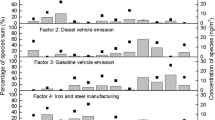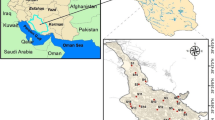Abstract
The inhalation bioaccessibility of polycyclic aromatic hydrocarbons (PAHs) is significant for accurately assessing the health risks posed by PM2.5-bound PAHs. In this study, 96 PM2.5 samples from Caofeidian, China, were investigated for PM2.5-bound PAH source appointment and bioaccessibility assessment during four seasons. PAH18 potential sources were identified by positive matrix factorization. The inhalation bioaccessibility of PAH18 was investigated by simulated epithelial lung fluid extraction. The incremental lifetime cancer risk (ILCR) model was subsequently used to evaluate the carcinogenic risk posed by PM2.5-bound PAHs in children, teenagers, and adults. Four potential sources of PM2.5-bound PAH18 were identified: industry emissions (44%), petroleum volatilization (30%), vehicle emissions (15%), and coal combustion (11%). The average inhalation bioaccessibility of PAHs ranged from 17.8% (dibenzo [a,h] anthracene) to 67.9% (fluorene). The ILCR values for children and teenagers were lower than the acceptable levels (10–6) in the four seasons considering inhalation bioaccessibility. However, the ILCR value of adults was higher than the threshold in winter (1.26 × 10–6). Source identification suggested that reducing industrial pollution was the primary measure for controlling PM2.5-bound PAHs in Caofeidian. Additionally, the inhalation bioaccessibility of PM2.5-bound PAHs was evaluated to precisely estimate the health risks caused by PAHs.
Graphical abstract









Similar content being viewed by others
Data availability
Not applicable.
References
Boisa N, Elom N, Dean JR, Deary ME, Bird G, Entwistle JA (2014) Development and application of an inhalation bioaccessibility method (IBM) for lead in the PM10 size fraction of soil. Environ Int 70:132–142. https://doi.org/10.1016/j.envint.2014.05.021
Chao S, Liu J, Chen Y, Cao H, Zhang A (2019) Implications of seasonal control of PM2.5-bound PAHs: an integrated approach for source apportionment, source region identification and health risk assessment. Environ Pollut 247:685–695. https://doi.org/10.1016/j.envpol.2018.12.074
Chen YC, Chiang HC, Hsu CY, Yang TT, Lin TY, Chen MJ, Chen NT, Wu YS (2016) Ambient PM2.5-bound polycyclic aromatic hydrocarbons (PAHs) in Changhua County, central Taiwan: seasonal variation, source apportionment and cancer risk assessment. Environ Pollut 218:372–382. https://doi.org/10.1016/j.envpol.2016.07.016
Cohen AJ, Brauer M, Burnett R, Anderson HR, Frostad J, Estep K, Balakrishnan K, Brunekreef B, Dandona L, Dandona R (2017) Estimates and 25-year trends of the global burden of disease attributable to ambient air pollution: an analysis of data from the Global Burden of Diseases Study 2015. Lancet 389:1907–1918. https://doi.org/10.1016/S0140-6736(17)30505-6
Collins CD, Craggs M, Garcia-Alcega S, Kademoglou K, Lowe S (2015) Towards a unified approach for the determination of the bioaccessibility of organic pollutants. Environ Int 78:24–31. https://doi.org/10.1016/j.envint.2015.02.005
Davoudi M, Esmaili-Sari A, Bahramifar N, Moeinaddini M (2020) Spatio-temporal variation and risk assessment of polycyclic aromatic hydrocarbons (PAHs) in surface dust of Qom metropolis. Iran Environ Sci Pollut Res Int 28:9276–9289. https://doi.org/10.1007/s11356-020-08863-5
Fang B, Zhang L, Zeng H, Liu JJ, Yang Z, Wang HW, Wang Q, Wang MM (2020) PM2.5-bound polycyclic aromatic hydrocarbons: sources and health risk during non-heating and heating periods (Tangshan, China). Int J Environ Res Public Health 17(2):483. https://doi.org/10.3390/ijerph17020483
Gao P, Guo H, Wang S, Guo L, Xing YF, Yao CH, Jia LM, Qi F, Hang J (2019a) In Vitro investigations of high molecular weight polycyclic aromatic hydrocarbons in winter airborne particles using simulated lung fluids. Atmos Environ 201:293–300. https://doi.org/10.1016/j.atmosenv.2018.12.054
Gao P, Hu J, Song J, Chen X, Ou C, Wang H, Sha CY, Hang J, Xing BS (2019b) Inhalation bioaccessibility of polycyclic aromatic hydrocarbons in heavy PM2.5 pollution days: implications for public health risk assessment in northern China. Environ Pollut 255:113296. https://doi.org/10.1016/j.envpol.2019.113296
James K, Peters RE, Laird BD, Ma WK, Wickstrom M, Stephenson GL, Siciliano SD (2011) Human exposure assessment: a case study of 8 PAH contaminated soils using in vitro digestors and the juvenile swine model. Environ Sci Technol 45:4586–4593. https://doi.org/10.1021/es1039979
Kastury F, Smith E, Juhasz AL (2017) A critical review of approaches and limitations of inhalation bioavailability and bioaccessibility of metal(loid)s from ambient particulate matter or dust. Sci Total Environ 574:1054–1074. https://doi.org/10.1016/j.scitotenv.2016.09.056
Kumar A, Sankar TK, Sethi SS, Ambade B (2020) Characteristics, toxicity, source identification and seasonal variation of atmospheric polycyclic aromatic hydrocarbons over East India. Environ Sci Pollut Res Int 27:678–690. https://doi.org/10.1007/s11356-019-06882-5
Li W, Wang C, Wang HQ, Chen JW, Shen HZ, Shen GF, Huang Y, Wang R, Wang B, Zhang YY (2014) Atmospheric polycyclic aromatic hydrocarbons in rural and urban areas of northern China. Environ Pollut 192:83–90. https://doi.org/10.1016/j.envpol.2014.04.039
Li SW, Li HB, Luo J, Li HM, Qian X, Liu MM, Bi J, Cui XY, Ma LQ (2016) Influence of pollution control on lead inhalation bioaccessibility in PM2.5: a case study of 2014 Youth Olympic Games in Nanjing. Environ Int 94:69–75. https://doi.org/10.1016/j.envint.2016.05.010
Li Q, Jiang N, Yu X, Dong Z, Duan SG, Zhang LS, Zhang RQ (2019a) Sources and spatial distribution of PM2.5-bound polycyclic aromatic hydrocarbons in Zhengzhou in 2016. Atmos Res 216:65–75. https://doi.org/10.1016/j.atmosres.2018.09.011
Li Y, Juhasz AL, Ma LQ, Cui X (2019b) Inhalation bioaccessibility of PAHs in PM2.5: implications for risk assessment and toxicity prediction. Sci Total Environ 650:56–64. https://doi.org/10.1016/j.scitotenv.2018.08.246
Liacos JW, Kam W, Delfino RJ, Schauer JJ, Sioutas C (2012) Characterization of organic, metal and trace element PM2.5 species and derivation of freeway-based emission rates in Los Angeles, CA. Sci Total Environ 435-436:159–166. https://doi.org/10.1016/j.scitotenv.2012.06.106
Liu WJ, Xu YS, Zhao YZ, Liu QY, Yu SY, Liu Y, Wang X, Liu Y, Shu T, Liu WX (2019a) Occurrence, source, and risk assessment of atmospheric parent polycyclic aromatic hydrocarbons in the coastal cities of the Bohai and Yellow Seas, China. Environ Pollut 254:113046. https://doi.org/10.1016/j.envpol.2019.113046
Liu X, Ji R, Shi Y, Wang F, Chen W (2019b) Release of polycyclic aromatic hydrocarbons from biochar fine particles in simulated lung fluids: implications for bioavailability and risks of airborne aromatics. Sci Total Environ 655:1159–1168. https://doi.org/10.1016/j.scitotenv.2018.11.294
Niu XY, Ho SSH, Ho KF, Huang Y, Sun J, Wang QY, Zhou YQ, Zhao ZZ, Cao JJ (2017) Atmospheric levels and cytotoxicity of polycyclic aromatic hydrocarbons and oxygenated-PAHs in PM2.5 in the Beijing-Tianjin-Hebei region. Environ Pollut 231:1075–1084. https://doi.org/10.1016/j.envpol.2017.08.099
Ounnas F, Jurjanz S, Dziurla MA, Guiavarc'h Y, Feidt C, Rychen G (2009) Relative bioavailability of soil-bound polycyclic aromatic hydrocarbons in goats. Chemosphere 77:115–122. https://doi.org/10.1016/j.chemosphere.2009.05.013
Sánchez-Piñero J, Moreda-Piñeiro J, Concha-Graña E, Fernández-Amado M, Muniategui-Lorenzo S, López-Mahía P (2021) Inhalation bioaccessibility estimation of polycyclic aromatic hydrocarbons from atmospheric particulate matter (PM10): influence of PM10 composition and health risk assessment. Chemosphere 263:127847. https://doi.org/10.1016/j.chemosphere.2020.127847
Taghvaee S, Sowlat MH, Hassanvand MS, Yunesian M, Naddafi K, Sioutas C (2018) Source-specific lung cancer risk assessment of ambient PM2.5-bound polycyclic aromatic hydrocarbons (PAHs) in central Tehran. Environ Int 120:321–332. https://doi.org/10.1016/j.envint.2018.08.003
US EPA (1997) Exposure factors handbook (Vol. 1). United States Environmental Protection Agency, Cincinnati
Wang J, Li X, Jiang N, Zhang WK, Zhang RQ, Tang XY (2015) Long term observations of PM2.5-associated PAHs: comparisons between normal and episode days. Atmos Environ 104:228–236. https://doi.org/10.1016/j.atmosenv.2015.01.026
Wang Q, Liu M, Yu Y, Li Y (2016) Characterization and source apportionment of PM2.5-bound polycyclic aromatic hydrocarbons from Shanghai city, China. Environ Pollut 218:118–128. https://doi.org/10.1016/j.envpol.2016.08.037
Wang J, Li X, Jiang N, Zhang WK, Zhang RQ, Tang XY (2017) Seasonal variation, spatial distribution and source apportionment for polycyclic aromatic hydrocarbons (PAHs) at nineteen communities in Xi'an, China: the effects of suburban scattered emissions in winter. Environ Pollut 231:1330–1343. https://doi.org/10.1016/j.envpol.2017.08.106
Wang G, Wang Y, Yin WJ, Xu T, Hu C, Cheng J, Hou J, He ZY, Yuan J (2020a) Seasonal exposure to PM2.5-bound polycyclic aromatic hydrocarbons and estimated lifetime risk of cancer: a pilot study. Sci Total Environ 702:135056. https://doi.org/10.1016/j.scitotenv.2019.135056
Wang S, Ji Y, Zhao J, Lin Y, Lin Z (2020b) Source apportionment and toxicity assessment of PM2.5-bound PAHs in a typical iron-steel industry city in northeast China by PMF-ILCR. Sci Total Environ 713:136428. https://doi.org/10.1016/j.scitotenv.2019.136428
World Health Organization (WHO) (2013) Health effects of particulate matter. Policy implications for countries in eastern Europe, Caucasus and central Asia. Publications, WHO Regional Office for Europe, UN City, Marmorvej 51, DK-2100 Copenhagen, Denmark.
Xie SY, Lao JY, Wu CC, Bao LJ, Zeng EY (2018) In vitro inhalation bioaccessibility for particle-bound hydrophobic organic chemicals: method development, effects of particle size and hydrophobicity, and risk assessment. Environ Int 120:295–303. https://doi.org/10.1016/j.envint.2018.08.015
Yan D, Wu S, Zhou S, Tong G, Li F, Wang Y, Li B (2019) Characteristics, sources and health risk assessment of airborne particulate PAHs in Chinese cities: a review. Environ Pollut 248:804–814. https://doi.org/10.1016/j.envpol.2019.02.068
Zhang Y, Zheng H, Zhang L, Zhang ZZ, Xing XL, Qi SH (2019) Fine particle-bound polycyclic aromatic hydrocarbons (PAHs) at an urban site of Wuhan, central China: characteristics, potential sources and cancer risks apportionment. Environ Pollut 246:319–327. https://doi.org/10.1016/j.envpol.2018.11.111
Zhang L, Xu HJ, Fang B, Wang HW, Yang Z, Yang WQ, Hao YL, Wang XS, Wang Q, Wang MM (2020) Source identification and health risk assessment of polycyclic aromatic hydrocarbon-enriched PM2.5 in Tangshan, China. Environ Toxicol Chem 39:458–467. https://doi.org/10.1002/etc.4618
Funding
This work was funded by the National Natural Science Foundation of China (No. 21305028), the Research Foundation of Education Bureau of Hebei Province, China (No. ZD2018014), the Tangshan Science and Technology Bureau Project (No. 19130209g), and the National Natural Science Foundation of China (No. 82073608).
Author information
Authors and Affiliations
Contributions
HZ and LZ performed the experiments and wrote the manuscript. FS and JJL performed the data analysis and presentation. BF and WQY helped perform the analysis with constructive discussions. CYM and MMW contributed significantly to manuscript revision. QW and YLH contributed to the study conception and funding acquisition. All authors have read and approved the final manuscript.
Corresponding authors
Ethics declarations
Ethics approval and consent to participate
Not applicable.
Consent for publication
Not applicable.
Competing interests
The authors declare no competing interests.
Additional information
Responsible Editor: Constantini Samara
Publisher’s note
Springer Nature remains neutral with regard to jurisdictional claims in published maps and institutional affiliations.
Supplementary information
ESM 1
(DOCX 26 kb)
Rights and permissions
About this article
Cite this article
Zeng, H., Zhang, L., Sun, F. et al. Inhalation bioaccessibility, health risk assessment, and source appointment of ambient PM2.5-bound polycyclic aromatic hydrocarbons (PAHs) in Caofeidian, China. Environ Sci Pollut Res 28, 47574–47587 (2021). https://doi.org/10.1007/s11356-021-13965-9
Received:
Accepted:
Published:
Issue Date:
DOI: https://doi.org/10.1007/s11356-021-13965-9




